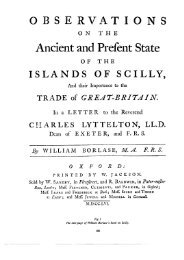Cornwall during the Iron Age and - Cornwall Archaeological Society
Cornwall during the Iron Age and - Cornwall Archaeological Society
Cornwall during the Iron Age and - Cornwall Archaeological Society
Create successful ePaper yourself
Turn your PDF publications into a flip-book with our unique Google optimized e-Paper software.
Exeter in <strong>the</strong> 3rd <strong>and</strong> 4th centuries AD than in <strong>the</strong> preceding period, <strong>and</strong> has <strong>the</strong> same pattern<br />
of occurrence in <strong>Cornwall</strong>. Significantly, South Devon ware forms include large jars with<br />
cordons <strong>and</strong> <strong>the</strong>ir increased import in <strong>the</strong> later Roman period may have reinforced <strong>the</strong> local<br />
Cordoned Ware tradition. Oxford wares have been identified on a number of sites such as<br />
Trethurgy <strong>and</strong> Porthmeor <strong>and</strong> probably reached <strong>Cornwall</strong> <strong>during</strong> <strong>the</strong> 4th century AD (Young,<br />
1977, 239).<br />
Imported artefacts of comparatively high value may have had a long life <strong>and</strong> <strong>the</strong>ir use for<br />
dating <strong>the</strong> archaeological contexts from which <strong>the</strong>y are recovered needs consideration. It may<br />
seem obvious on a small excavation to use a piece of Antonine samian to date <strong>the</strong> site. At<br />
Trethurgy, sixty samian sherds from a minimum of fourteen vessels were found, despite <strong>the</strong><br />
complete excavation. The largest quantity of samian came from <strong>the</strong> 4th century midden which<br />
was <strong>the</strong> earliest context to produce Oxford Ware on <strong>the</strong> site. In turn, some of <strong>the</strong> best pieces<br />
of Oxford Ware were found in <strong>the</strong> deliberate infill of a structure which contained post-Roman<br />
import wares <strong>and</strong> should date to <strong>the</strong> 6th century AD. Fine wares could thus be deposited<br />
perhaps two centuries after <strong>the</strong>ir manufacture, which increases <strong>the</strong> difficulties of producing<br />
a dateable sequence for <strong>the</strong> Cornish gabbroic wares of <strong>the</strong> Roman period.<br />
About 95% of all pottery from Roman <strong>Cornwall</strong> is gabbroic. The as yet unlocated <strong>Iron</strong><br />
<strong>Age</strong> pottery centres, presumably on <strong>the</strong> Lizard, continued, gradually influenced by Roman<br />
forms. A brief period of experiment in <strong>the</strong> late 1st <strong>and</strong> early 2nd centuries has already been<br />
mentioned with reference to finds from Carvossa. Thereafter <strong>the</strong> principal products were<br />
simple jars, some with cordons, which gradually got larger <strong>and</strong> more poorly made. Bowls<br />
<strong>and</strong> dishes were introduced <strong>during</strong> <strong>the</strong> 1st century AD with St Mawgan-in-Pydar Type R<br />
(Threipl<strong>and</strong>, 1956, 66), <strong>and</strong> continue with flat, 'pie dish' rims starting in <strong>the</strong> 2nd century.<br />
These develop into 'grooved' or 'proto-flanged' forms by <strong>the</strong> late 2nd century <strong>and</strong> into<br />
flanged bowls by <strong>the</strong> late 3rd. This sequence appears at first sight to copy that of Dorset<br />
black-burnished bowls, but similarities are general ra<strong>the</strong>r than precise. It is more likely to<br />
be a general reflection of stylistic trends, with <strong>the</strong> flanged bowls influenced by metal forms<br />
such as <strong>the</strong> Hallivick pewter bowl. There is no definite evidence for <strong>the</strong> use of <strong>the</strong> potter's<br />
wheel. Well-made vessels, highly fired <strong>and</strong> of well-levigated clay, represent careful<br />
application of traditional techniques. Roughly-made jars <strong>and</strong> bowls, of a type often labelled<br />
'h<strong>and</strong>-made' in contra-distinction to 'wheel-made' occur throughout <strong>the</strong> period. They are<br />
certainly present from <strong>the</strong> earliest contexts at Trethurgy. The proportion of roughly-made<br />
forms increases in <strong>the</strong> later Roman period. At Trethurgy <strong>and</strong> at Grambla (Saunders, 1982),<br />
occupied throughout <strong>the</strong> 5th century AD, <strong>the</strong>re were no detectable changes in form, <strong>and</strong> it<br />
is only in <strong>the</strong> 6th century that Roman-type gabbroic pottery becomes scarce. The potting<br />
centres may have continued <strong>during</strong> <strong>the</strong> 5th century because <strong>the</strong>y were less dependent on a<br />
monetary economy than kilns in o<strong>the</strong>r parts of <strong>the</strong> country.<br />
O<strong>the</strong>r economic activities are less easy to identify. Most domestic sites produce evidence<br />
of small-scale metal working. The manufacture of some stone mortaria took place on<br />
domestic sites (unfinished examples are known from Castle Gotha <strong>and</strong> Trethurgy), although<br />
a greisen h<strong>and</strong>led bowl mortarium has been found as far afield as Richborough (Roach Smith,<br />
1850, 104). The production of salt has been demonstrated on <strong>the</strong> Lizard, at Trebarveth in<br />
<strong>the</strong> 3rd <strong>and</strong> 4th centuries (Peacock, 1969a), <strong>and</strong> at Carngoon Bank (from at least <strong>the</strong> 3rd to<br />
<strong>the</strong> 6th centuries AD (McAvoy, 1980). A major <strong>and</strong> distinctive feature for <strong>Cornwall</strong> was <strong>the</strong><br />
production of tin. This is generally considered to have been of little importance <strong>during</strong> <strong>the</strong><br />
1st <strong>and</strong> 2nd centuries AD, when Iberian mines were supplying <strong>the</strong> Empire's needs. (Could<br />
this factor have anything to do with <strong>the</strong> suggested dislocation of Cornish settlement patterns<br />
in <strong>the</strong> 2nd century AD?). In <strong>the</strong> 3rd century <strong>the</strong> Iberian mines were in decline, tin was<br />
increasingly used in coinage, <strong>and</strong> in Britain <strong>the</strong> dem<strong>and</strong> for tin went up becaue of <strong>the</strong> growing<br />
129




